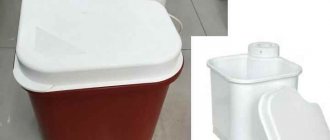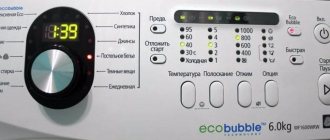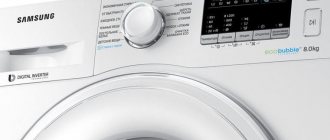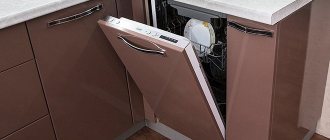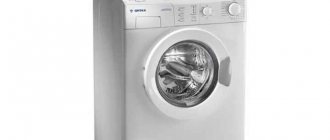It is difficult for the modern consumer to choose among the many washing machines. Maximum loading weight, dimensions, availability of additional functions - parameters considered when searching for the desired model.
Before purchasing, those living in rented housing often ask the question of how much a washing machine weighs. This question worries those who pick up an electrical appliance from a point of sale during pickup.
Factors influencing the desired parameter
Sometimes sellers forget to indicate the weight of the washing machine. By paying attention to some points, you can roughly estimate it.
The increase in the mass of the device is facilitated by:
- Case material. The steel used in the production of components can make the model heavier. The presence of plastic parts, on the contrary, reduces the weight of the machine.
- Dimensions. The larger the body of an electrical appliance, the heavier it is.
- Loading weight. A large amount of linen and clothing is placed in a wide and deep drum, which is also made of heavy stainless steel.
- Availability of additional functions. Built-in drying and steaming significantly increase the weight of the machine compared to simpler models.
Minimum load
Let's start with the minimum amount of laundry you can put in the drum, because the minimum is just as important as the maximum. The number of items in the drum during washing will determine the degree of vibration during spinning, and therefore the period of uninterrupted operation of the machine.
An unbalanced drum will begin to vibrate more forcefully. Even if the machine is not a narrow model and is installed well, internal vibration remains, and it can cause microcracks. We hope now you understand why you shouldn’t wash just one pillowcase or one panties.
Now let's talk about the number that is indicated on the front panel of the washing machine, or more precisely, about its maximum load. Today, automatic machines can have a load of 8, 10 and even 12 kg of dry laundry. In reality, this is a lot; for clarity, let’s give an example: a set of bed linen consisting of one duvet cover, one sheet and two pillowcases weighs on average 1.3 kg when dry.
We suggest you read: How to clean the inside of an iron from scale at home
The technical meaning of the maximum load of the machine in kilograms indicated in the passport is as follows - the machine must rotate the indicated weight without overloading the engine during its service life. But this does not mean at all that you should put such a quantity of linen and clothes into the drum every time, weighing it on scales, and it is unlikely that you will succeed.
In reality, we wash clothes and things that are bulkier and therefore weigh less. In addition, water absorption depends on the density and composition of the fabric. Imagine a sofa blanket. When dry, it easily fits into a regular basin. But washing it in a basin by hand will be extremely difficult, almost impossible. It is much easier to wash it in a bathtub, which is several times larger in volume.
The same is true in the drum of a washing machine. The larger the item, the larger the load and drum volume should be. If you are going to wash jackets, down jackets, blankets in the machine, then you need to choose a machine with a larger load so that the clothes are washed well. The manufacturer takes this into account, and in the instructions for the machine writes the load of laundry for a specific washing mode.
After analyzing this table, we can conclude that regardless of the manufacturer of the washing machine, its load under different modes is approximately the same. The least amount of wool you can put in the drum is because it is the most voluminous and absorbs a lot of water. You shouldn't machine wash a lot of synthetic and delicate fabrics, otherwise they won't stretch and will be too wrinkled.
The most things you can load into the machine are cotton items, bedding and baby clothes. This does not mean that the drum should be filled to capacity. The drum must be filled 2/3 full, so the laundry can be washed and rinsed well. In addition, this will allow the laundry to be evenly distributed throughout the drum, which will not cause imbalance or poor spinning of the laundry. An imbalance can cause the machine to stop and an error to appear on the display, such as the ue error on a Samsung machine.
The amount of clothes to be washed should vary within the limits indicated by the manufacturer. Thus, the maximum permissible weight is always written on the body of the washing machine and additionally in the instructions for it. It is worth noting that the minimum load is indicated extremely rarely. Usually we are talking about 1-1.5 kg of clothes. Correct operation of the washing machine is possible only if there is no underload or overload.
The maximum weight specified by the manufacturer is not suitable for all programs. Usually the manufacturer gives recommendations for cotton items. Thus, mixed and synthetic materials can be loaded at approximately 50% of the maximum weight. Delicate fabrics and wool are completely washed at the rate of 30% of the specified load. Additionally, the volume of the drum should be taken into account. For 1 kg of dirty clothes, about 10 liters of water are required.
Maximum permissible load depending on the washing machine and fabric type:
If you put less than 1 kg of clothes in the washing machine, a malfunction will occur during the spin cycle. Low weight leads to incorrect load distribution on the drum. Clothes will remain wet after washing.
Types of light washing machines
Today there are automatic and activator types of devices for washing clothes on sale. The latter were popular two decades ago.
One of the lightest washing machines is Renova WS-30ET. Production is carried out by Nova LLC, located in the Rostov region, in the city of Aksai. The dimensions of the device are: width – 41 cm, depth – 33 cm, height – 63.5 cm. Weight is 6.7 kg. You can load 3 kg of laundry. The case is plastic.
Traditional small washing machines with a body depth of up to 40 cm weigh about 50–60 kg. For example, Zanussi ZWSO6100V with a maximum load of 4 kg and a depth of 34 cm weighs 52 kg. The LG F10B8SD0 model can hold four kilograms of laundry and weighs 56 kg. Hotpoint-Ariston VMUF 501 B with a depth of 34.8 cm has a weight of 57.5 kg.
Weight of standard washing equipment
The weight of modern washing equipment varies between 30-100 kg and depends on the class, functional features and built-in equipment. Up to 50 kg there are miniature products that can be built under the sink or in a special compartment of the kitchen unit, more substantial specimens weigh up to 70 kg, and then there are heavyweights with high spin speeds.
Need to know! The exact weight of the machine is indicated in its technical passport, so when choosing a model, carefully read all its data; no specialist will give you more detailed information.
Washing appliances with a depth of up to 50 cm
These models can accommodate up to 8 kg of laundry. “Snow White” B 5500-5 LG is 75 cm wide and 84 cm high. It weighs only eighteen kilograms. The body of the model is plastic. You can wash up to 5.5 kg of clothes at a time.
Daewoo WM-ELC80YG can accommodate 6 kg of laundry. Dimensions are: width - 52.5 cm, height - 86.3 cm, depth - 53.5 cm. Device weight - 25 kg.
The choice of such top-loading machines is small, but they weigh a little. If necessary, even a woman can move it.
What weight is taken into account when loading a washing machine?
The manufacturer of household washing equipment always indicates how much laundry can be put in the drum. This one of the main characteristics is often displayed on the front of the machine in large font. And if a loading weight of 5 kilograms is indicated, this means that 5 kg of dry items can be placed in the drum
When deciding to buy a machine, new owners pay attention specifically to the maximum load. After all, the large weight of the laundry will allow you to wash less often and save energy and water
Rice. 1 - Approximate weight of laundry
This is because during spinning the load is distributed evenly across the laundry. If there is insufficient weight, the walls of the linen compartment will be damaged. A high spin speed with low weight will disrupt the correct load distribution. Therefore, the machine will fail faster.
The excess of clothes in the drum overloads the electric motor and bearings. Constantly overloading the motor can cause a short circuit and fire. Excessive weight of laundry results in improper washing and rinsing. Things are not washed; stains from the powder and conditioner remain. Loading to capacity prevents the machine from using the required amount of water, so the clothes remain incompletely washed. And the parts of the washing machine wear out.
As a result, underweight and overweight of things in an automatic machine leads to inevitable breakdown of the device. It is worth following the instructions on weight parameters so that the washing is of high quality and the equipment serves the owners properly. It is the dry weight of the laundry that is indicated on the dashboard and in the instructions.
The table in the machine’s passport will help you determine the exact loading weight. Some models are designed for small volumes and can hold up to 5 kg; standard machines can wash from 5 to 8 kg of laundry, but there are also powerful machines with a load of 9 to 12 kg. If the maximum permissible weight of things is indicated both on the car itself and in the passport, then the minimum weight is not always prescribed
And it is also important to take it into account. In the absence of visual data on the minimum load, you should not run a wash of less than one and a half kilograms
Compliance with this rule will protect against unexpected breakdowns and functional failures.
Rice. 2 — Laundry weight table in the washing machine passport
Loading …
Washing appliances with a depth of up to 50 cm
The maximum weight of a load of laundry is 6 kg. The width is 60 centimeters, the height is 85 cm, the depth at the top of the body is about 44 cm. The hatch protrudes by about 4 cm. Therefore, the depth of the device with the hatch closed is about 48 cm. This should be taken into account before purchasing a machine and placing it in cramped conditions: narrow bathroom, small kitchen. You can put up to six kilograms of linen and clothes. This is a standard one-time load for machines of this size.
Weight of some models with the described parameters:
- LG FH0B8ND3 - 59 kilograms;
- Samsung WF60F1R2G0WDBY - 53 kg;
- Bosch WLL24260BL - 63 kilograms;
- Indesit BWSD 61051 1 BY - 62.5 kg;
- BEKO WRE 6512 ZSS - 55 kg;
- Hotpoint-Ariston RSM 601 W - 62.5 kg
Which one is better to choose?
Which is better: a light or heavy machine? If weight is important to you when choosing a washing machine, consider the following information. When the full washing cycle approaches the spin mode, the speed increases to the maximum and the unit begins to vibrate. If the washing machine is light, then it can not only shake and vibrate, but even jump at the installation site. In this case, counterweights are not always able to save the situation, especially in case of incorrect installation.
When choosing a washing machine, focus on weight in the range of 55-80 kilograms. Such devices are quite stable and practically do not vibrate, unlike lightweight options.
There are many questions that arise before purchasing a washing machine, as there are countless options on the market. The models differ not only in design and functionality, but also in weight. To answer the question “how much does an automatic washing machine weigh”, you need to take into account more than one factor. Let's take a closer look.
The weight of the washing machine plays an important role, although you may not always think about it. For example, if you do not have permanent housing or are forced to move frequently, then choosing a lighter model will be an irreplaceable help for you in the future.
What factors does weight depend on?
Different models may differ in weight by up to 10 kg. The final weight is influenced by the body, drum volume, installation option, and additional functions. Also, do not forget about the counterweights that are used to balance the drum.
Just imagine how 5 kg spins in a drum at a speed of 1000 revolutions per minute, and incorrectly distributed laundry on the surface creates a problem; to eliminate the imbalance, balancers are used.
Without balancers, your washing machine would go on a trip with your things, although not for long; stabilizers won’t last long. The balancer itself resembles a small concrete block, but the shape and size of the counterweight depends on the specific manufacturer and the material from which it is made.
To select the appropriate model you need to determine:
- Place (measure width, depth and height);
- Select the type of machine (vertical or horizontal loading type).
The lineup
The model range of automatic machines is divided into two main types of frontal and horizontal loading, and after that each type is divided into subtypes. For convenience, a classification has been compiled.
Full size model
The height of a full-size model is from 85 to 90 centimeters, the width is from 60 to 85 centimeters, the depth of this model is 60 cm. The permissible load of laundry weighing up to 7 kg.
Narrow model
The standard height of the narrow model is 85 cm, the width is no narrower than 60 cm, and the depth is up to 40 cm. Single loading capacity is up to 5 kg.
Miniature model
The standard height of the mini-machine is 85 cm, the width is no more than 60, and the thickness is 5-7 centimeters less than the narrow model and reaches 32 cm. The maximum load of laundry is 4 kg.
Compact model
The height of the compact washing machine is 85 cm, width 60, depth 44, and the entire load of laundry is max 3.5 kilograms.
Built-in models
The height of built-in models may differ from the standard and varies up to 82 cm, width about 60, depth 55, and the maximum load can reach 5 kg.
Large vertical models
Height up to 1 m, width 0.4 m, depth 0.6 m, but the capacity is simply amazing at 7 kg.
Standard vertical model
A standard vertical loading machine has a height of 0.6 to 0.85 m, a width of 0.4 m, and a depth of 0.6 m. Normal loading is about 5.5 kg.
Standard weight
The approximate weight of an empty washing machine ranges from 55-75 kg. Statistics are taken from open sources of the most popular washing machine models.
In the video you can see more accurate information
How to choose
For small bathrooms, it is better to choose narrow models with vertical loading. Be aware that in order for narrow models to create less vibration during spinning, manufacturers specially make them heavier.
By the way, a new auto-balancing function has appeared on the washing machine market. It works on the principle of regulating the rotation speed of the drum, which reduces vibration noise.
Heavy or light?
A non-standard thought rarely comes to buyers, but those who are interested cannot sleep at night for quite a long time until they find the answer.
There are myths that a lightweight washer will be unstable due to lack of weight. This opinion appears when you look at the spinning process and are amazed that she can do this, but you can’t.
By choosing heavy machines, you expose yourself to great inconvenience; it’s inconvenient to carry onto floors, moving from place to place is beyond the power of one woman, and when spinning, such a machine can hurt you.
Washing appliances with a depth of more than 50 cm
There are many washing machines with a load of 8 kilograms. The dimensions are equal: width - 60 centimeters, height - 85 cm. Standard depth - 55 cm. They can spin clothes and have 13 or more programs. Drum volume is more than 50 liters.
Automatic washing machines with these parameters weigh:
- LG F1096TD3 - 62 kg;
- Samsung WW80J5545FX - 61 kilograms;
- Whirlpool AWOC 0714 - 68 kg.
Among the machines with a depth of about 60 centimeters, there are models with a maximum load of ten kilograms. The width of such models is 60 cm, the height is 85 cm. These devices have a modern design and many additional functions: steam treatment, self-cleaning function. The Samsung and Elgie models can be connected to a smartphone. This will allow you to start the wash remotely or change the program without leaving the couch or while on the road from work.
The weight of front-loading automatic washing machines with a maximum load of laundry of 10 kilograms is:
- LG F4J9JS2S - 68 kg;
- Samsung WW10M86KNOA - 83 kg;
- Hotpoint-Ariston RZ 1047 B EU – 75 kg
Significant advantages of vertical machines
Top-loading washing machines open not from the side, but from the top, and this is the reason for the controversy with supporters of front-loading models. Many people think that the lack of an additional “shelf” or “table” in the bathroom is a serious omission. True, manufacturers of front-facing models do not recommend placing anything on the surface, since small objects constantly fall to the floor during the spin cycle, and large ones can deform the panel, but in practice, most owners use the additional space to store powders, shampoos or towels.
Seriously speaking, it is difficult to find any shortcomings in a vertical washing machine. It is much better protected from leaks, which often occur in frontal models due to deformation or damage to the cuff. If you forget to put a T-shirt or robe in the drum, you can simply pause the machine and add items without waiting for the wash to finish.
The ergonomics of the models is admirable. To load laundry into the tank or get it out, you don't have to squat or bend over. This is very important for older people, pregnant women and those who suffer from diseases of the musculoskeletal system. However, others will also appreciate this undoubted advantage.
In terms of the number of modes, top-loading washing machines are not inferior to their eternal competitors. They have programs for quick washes, delicate cycles for silk and delicate fabrics, powerful long cycles for cotton items and much more. Spinning is carried out at high speeds, so that things dry quickly after being removed from the drum.
Another significant plus is the reduced number of drum-related breakdowns. The design of vertical washing machines is designed to withstand heavy loads, and the tank is mounted more securely, so problems arise less often.
The disadvantages include higher cost. You will have to pay 20-30% more for a top-loading washing machine, but the difference will be well worth it due to the durability of the equipment. The second drawback is the not very wide range of models. In the catalogs of well-known brands you can usually find several washing machines of this type, while less famous manufacturers sometimes have only 1-2 models. It will not be possible to build the machine under the sink or countertop, but this is not necessary, since it will not be difficult to find a place for the equipment.
Compactness
The body dimensions of vertical washing machines are smaller than those of front-facing ones. With the same maximum load, you will get a significant gain in floor space. Since the door opens upward, equipment can be safely placed in a narrow passage: taking things out and putting them in will be convenient.
Good maximum load
We have already mentioned that top-loading washing machines have a higher capacity than front-loading models. Their drum can hold from 3 kg (for compact wall-mounted or tabletop models) to 8 kg of things.
It is not recommended to exceed the maximum load level of a particular washing machine so that the equipment does not break down. Some models are capable of weighing laundry and even beeping when overloaded.
Reloading laundry
The most important advantage of top-loading washing machines is the ability to reload laundry. With the best branded models, all you have to do is pause the wash. The electronic control system will “park” the drum so that its door is at the top. All you have to do is open it, add items, close the washing machine and resume the program.
This function is very convenient, because with its help you can first wash items made of thick fabric, and at the end add light and delicate wardrobe items made of silk, chiffon, lace.
Common breakdowns
Most often, the following elements fail in Samsung washing machines:
- heating element. If it burns out, it needs to be replaced.
- Drive belt. In the vast majority of cases, it simply wears out during use. The belt cannot be repaired and must be replaced.
- Inlet valves. If they are clogged, they need to be cleaned.
- Drain pump, seals and bearings. Most often, repairs come down to replacing parts.
This section will tell you about repairing Samsung washing machines.
Error codes
If any element fails, the smart technology independently determines this and issues a characteristic error code. The most common of them:
- 1E – failure of the pressure switch;
3E, 3E1 – the tachometer is broken;- 4E, 4E1 – there is no water in the tank;
- 5E – problem in the drainage system;
- 8E – motor failure;
- 9E1, Uc - power problems;
- CE – water overheating;
- HE, HE1, HE2 – failure of the heating element;
- LE – water leak;
- OE – tank is full of water;
- tE1, tE2, tE3 – thermal sensor failure;
- Sud – excess foam.
All error codes are discussed in this section.
Features of washing machines from popular manufacturers
Perhaps the first thing a potential buyer pays attention to is the brand and manufacturer of the device. This is a justified approach, because the reliability of the device and a number of its main characteristics largely depend on the brand. SAMSUNG, Indesit, LG, Ardo and others are a guarantee of high product quality, reliability and durability.
Most manufacturers offer models of various “weight categories”, trying to cover the market as much as possible. Thanks to this, it is easy to select a device “by weight” in the catalog of any manufacturer.
Samsung
Most Samsung washing machines weigh 55-65 kg. Innovative solutions by engineers from South Korea made it possible to create a medium-weight device with excellent consumer characteristics.
A striking example is SAMSUNG WF60F1R2E2WD. This is a free-standing machine weighing 57 kg. It belongs to the narrow class, has a depth of only 45 cm, and is designed to load up to 6 kg of laundry.
Indesit
The weight of most common Indesit models is in the medium weight category. Most devices have a mass in the range of 50-80 kg, which can be safely called the “golden mean”. A car with similar indicators:
- has sufficient stability;
- not subject to excessive vibration;
- has average “transportability” indicators.
With all this, these devices have all the necessary functionality and sufficient power to perform washing of any level of complexity. Almost all Indesit models can wash delicate linen and winter jackets with equal success.
Example – INDESIT IWSE 61253 C ECO. This is an excellent solution for the average family. With a depth of 42 cm, the device belongs to a narrow class. Due to its fairly large weight - 61 kg and a low center of gravity, it has good noise levels and excellent stability.
Article on the topic: How to choose a belt for a washing machine
Bosch
Bosch offers solutions for every need. Front-loading and top-loading devices are available. It will not be difficult for a buyer to buy a car of a light class and a real “heavyweight”. Regardless of the type of device, the manufacturer guarantees excellent quality and good consumer characteristics.
When choosing a car for your home, you should pay attention to an additional function - an automatic balancing system. This useful option ensures that even modest weight machines are free from excessive noise and vibration.
When choosing a device for a large family, you should pay attention to the full-sized washing machine BOSCH WAB 24262. Its impressive dimensions, its depth is 55 cm and its weight of 66 kg provide excellent stability and low noise level during washing.
LG products are consistently popular in the market. The main line of the manufacturer is cars that are in the “golden mean” of the weight rating. The manufacturer offers a variety of models, both front-loading and vertical-loading. In any case, the machine is guaranteed to cope with the responsibilities assigned to it. Transportation will not cause any particular difficulties, and stability will be beyond praise.
As an example, we can mention the LG F-1096ND3. This device has a mass of 60 kg, front loading, and can wash up to 5.5 kg of laundry in one go, which is optimal for the average family.
Candy
Kandy machines are well-deservedly popular among users all over the world. With a fairly affordable price tag, devices from this manufacturer are an excellent choice for a family with an average income.
One example of products from this brand is Candy GVW 264DC. The front-loading device weighs 70 kg. It is thanks to its weight, with a depth of only 44 mm, that it is characterized by stability, low noise, and an acceptable level of vibration.
Ariston
Most devices from this popular Italian manufacturer weigh 60-70 kg. These indicators provide high stability regardless of the model and type of load; however, in the case of frequent travel, the Ariston car may not seem very convenient.
Article on the topic: How to defrost a Samsung rl28fbsw refrigerator
An example of a device is a narrow washing machine HOTPOINT ARISTON RSSG 603. Weight - 61 kg, depth 42 cm. It is distinguished by a large number of programs, low energy consumption, acceptable levels of noise and vibration.
Atlant
Belarusian-made washing machines are, first of all, distinguished by their affordable prices and excellent quality. The manufacturer offers a wide range of products. For the most part, Atlant washing machines are presented in the “middle weight” range.
As an example, consider ATLANT 60У1010-010. This is a narrow, freestanding washing machine in the mid-price segment. Weight – 62 kg, it has good capacity; in one wash you can wash up to 6 kg of laundry. The body depth is only 41 cm, which does not in any way affect stability due to sufficient mass and a low center of gravity.
Choosing an automatic washing machine for your home is a responsible matter, there are no trifles. It is better to spend a little time studying the basic parameters of the device than to be upset later because the purchase does not live up to expectations. Everything must be taken into account without exception, and the weight of the washing machine, especially in combination with its dimensions, is far from a trifle; it is one of the most important characteristics of the device.
Various options
There are several ways to get rid of your old machine:
- Dispose of as household appliances. It must be said right away that this option will cost you 1500-2000 rubles. The fact is that household appliances are disposed of in special landfills, after being shredded. The funds will be used to pay for transportation and the processing service itself.
- Place advertisements in a newspaper or on the Internet. There are a large number of people who want to take away their old washing machine. You can consider selling it (if the machine is in good condition) or giving it away for free.
- Return it to the store. Of course, we are not talking about returning it. Many household appliance stores hold promotions in the “Change new for old” format.
- Donate a car to an orphanage. If your washing machine is still operational, you can donate it to an orphanage. As a rule, such institutions always need help.
- Sell your washing machine for scrap.
In fact, the latter method is most often used - washing machines are sold for scrap. This is due to the fact that most old cars are thrown away due to malfunctions and it is impossible to sell or donate them. Then scrap metal collection points come to the rescue.
Location of counterweights
Finding counterweights in an automatic machine is very easy. The easiest place to get to is the top weight. However, there are always more problems with dismantling this block. To “climb” to it, you need to:
- de-energize the automatic machine;
- close the shut-off valve responsible for the water supply;
- move the washing machine away from the wall to have free access to all sides of the body;
- Use a screwdriver to unscrew the two screws holding the top panel of the machine;
- Remove the housing cover by moving it slightly back and lifting it up.
The upper counterweight will be immediately in front of your eyes. The unit must be inspected for defects. Next, you need to evaluate the condition of the front weights; to do this, you will have to remove the front wall of the case. The further algorithm of actions will be as follows:
- pull out the powder receptacle;
- Unscrew the bolts located around the perimeter of the control panel;
- unhook the “tidy” from the body and carefully place it on the machine so as not to damage the wiring;
- remove the lower false panel, behind which the garbage filter is hidden, by picking it up with a screwdriver;
- open the hatch door wide;
- use a screwdriver to hook the outer clamp holding the drum cuff and remove the ring;
- tuck the rubber seal inside the drum;
- slightly tilt the body of the machine back, insert your hand between the tank and the front wall, feel for the UBL and disconnect the chip with the blocker contacts;
- Unscrew the screws holding the front wall;
- remove the front panel.
Now you can inspect the front counterweights. If there are many cracks on them, the elements will have to be replaced. We'll show you how to remove damaged concrete weights to make room for new blocks.

